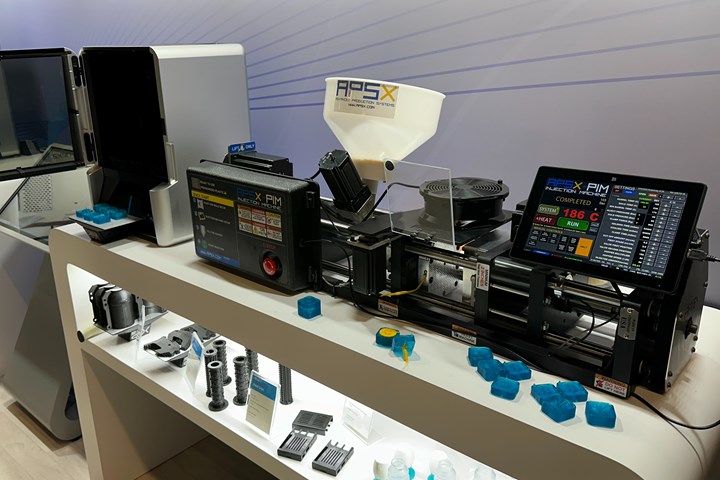Freeform Injection Molding Now Integrated With Desktop Injection Molding Machine
Injection molding machine supplier APSX-PIM now offers a comprehensive desktop FIM package using Nexa3D’s technology to 3D print molds, design parts.
In a recent collaboration, injection molding machine supplier APSX-PIM and Nexa3D have integrated the APSX-PIM desktop injection molding machine with Nexa3D’s freeform injection molding (FIM) 3D printers, culminating in new possibilities for product design, prototyping and production.
The APSX-PIM offers a compact footprint, user-friendly interface and versatility, while FIM enables precise, high-speed, 3D printed soluble tooling. Together, they are said to seamlessly transition from 3D printing prototypes to injection molded production parts, all within a single, integrated ecosystem, eliminating the need for costly and time-consuming tooling processes, reducing lead times and maximizing productivity.
When making parts with Nexa3D XiP and APSX-PIM:
- Design: Begin the process by creating a 3D model of the desired part using CAD software. Leverage the freedom of design afforded by FIM to explore intricate geometries and complex structures.
- 3D Printing with Nexa3D XiP: Once the design is finalized, transfer the model to the Nexa3D XiP printer, which alters digital designs into high-resolution 3D printed prototypes.
- Validation and Iteration: Evaluate the printed prototype to ensure that it meets design specifications.
- Mold Creation: Once the prototype is approved, proceed to create the mold using the nexa3D mold generator software or another CAD software. 3D print the mold by using the xMOLD material on the nexa3D XiP printer.
- Injection Molding: With the mold in place, initiate the injection molding process using the APSX-PIM. The machine’s precise control and repeatability ensure consistent results, delivering high-quality parts with each cycle.
- Final Inspection: Conduct a thorough inspection of the molded parts to verify dimensional accuracy and to test the part functionality.
Learn more about the technology’s capabilities and applications.
Related Content
-
MMT Chats: California Mold Builder Discusses the Difficulties with Silicone Molding and the Power of the Magic 8 Ball
MoldMaking Technology Editorial Director Christina Fuges sits down with M.R. Mold President and Owner, Rick Finnie, to discuss how he began his moldmaking career, M.R. Mold's LSR Education, and the struggles of working with silicone. This episode is brought to you by ISCAR with New Ideas for Machining Intelligently.
-
How to Make Data Work for Mold Productivity and Performance
The use of digital workflows improves the impact of mold design libraries, conformal cooling and machine learning.
-
The Benefits of Vertically Integrating Metal 3D Printing and Machining
Having 3D printing and machining within one organization enables Addman’s engineers to collaborate and consolidate so it can quickly make successful metal 3D-printed parts.








.jpg;maxWidth=300;quality=90)




